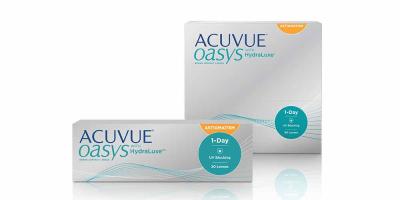You are currently not taking any of our courses.
Educate both your staff and your customers with our different courses!
ACUVUE® OASYS 1-Day for ASTIGMATISM features Eyelid Stabilized Design, which allows contact lenses to realign naturally with every blink3,4 and provide consistent comfort and vision across daily activities and challenging environments.5

8.5 mm base curve/14.3 mm diameter
Power ranges
Sphere:
-6.50D to -9.00D (in 0.50 D steps)
0.00D to -6.00D (in 0.25 D steps)
+0.25D to +4.00D (in 0.25 D steps)
Cylinders:
-0.75D, -1.25D, -1.75D, -2.25D*
Axes:
10°-180° in 10° steps for 0.00D to -6.00D
70°-110° and 160°,170°,180°, 10° , 20° for -6.50D to -9.00D and +0.25D to +4.00D
* cylinder -2.25D available in power range 0.00D to -6.00D and axes 10°, 20°, 70°, 80°, 90°, 100°, 110°, 160°, 170°, 180°
Single usage: 1-day replacement
| Lens material | Senofilcon A |
| Technology | Polyvinyl pyrrolidone (PVP) using HydraLuxe® Technology |
| Oxygen transmissibility (Dk/t) (boundary and edge corrected)^ |
129 × 10–9 (–3.00D lens) |
| Water content | 38% |
| UV-blocking** | 99% UV-B and 96% UV-A |
| Center thickness | 0.08mm (–3.00D) |
| Handling features |
Visibility tint |
| Package sizes | 30 lenses 90 lenses |
Packing solution contains boric acid and disodium tetraborate (sodium borate) to control the pH of the solution.
^ All Dk values: Fatt units at 35°C, determined via polarographic method (boundary & edge corrected).
**All ACUVUE® Brand Contact Lenses have Class 1 or Class 2 UV-blocking to help provide protection against transmission of harmful UV radiation to the cornea and into the eye. UV-absorbing contact lenses are NOT substitutes for protective UVabsorbing eyewear such as UV-absorbing goggles or sunglasses because they do not completely cover the eye and surrounding area. UV transmission measured with –1.00D lens.
1. JJV Data on File 2021. HydraLuxe® Technology Definition.
2. JJV Data on File 2021. Proportion Astigmats Accommodated with ACUVUE® Brand Contact Lenses for ASTIGMATISM.
3. JJV Data on File 2008. Stabilization mechanism for Accelerated Stabilization Design.
4. JJV Data on File 2010. ASD technology of 1-DAY ACUVUE® MOIST Brand Contact Lenses for ASTIGMATISM.
5. JJV Data on File 2016. Single-masked, 2-visit, bilateral wear, single arm 1-week daily wear dispensing study of 162 US habitual toric soft contact lens wearers in both eyes, with a spherical distance refraction of -1.50D to -4.00D (inclusive), cylinder correction of 0.75D to 1.50D after vertex correction (inclusive), and refractive cylinder axis within 180±15 degrees or 90±15 degrees.
A unique tear inspired design1 that works by integrating with a patient’s own tear film.1# For patients in challenging environments - correction with the right lens can help with symptoms such as blurred vision and feelings of tired eyes, dryness, and discomfort.6
Works naturally with the eyelids, helping to keep the lens in the correct position:7
Lens interacts with both eyelids to stabilize quickly and maintain position7
ACUVUE® OASYS 1-Day for ASTIGMATISM features Eyelid Stabilized Design, which allows contact lenses to realign naturally with every blink3,4 and provide consistent comfort and vision across daily activities and challenging environments,5 despite the effect of gravity or head movements.7
Packing solution contains boric acid and disodium tetraborate (sodium borate) to control the pH of the solution.
# Designed to support the functions of the tear film
*Vertical heterophoria possibly caused by prism dissociation due to the presence of induced optical prism is a relevant factor for practitioners to consider when fitting toric contact lenses for monocular astigmats or those requiring a mix of toric soft contact lens designs.(1)(2) Clinical studies have not been done to fully characterize the clinical effects of differences in base down prism among different contact lenses. 1-Jackson D, Bedell HE. Vertical heterophoria and susceptibility to visually induced motion sickness. Strabismus. 2012;20(1):17-23. 2. duToit R, Ramke J, Brian G. Tolerance to prism induced by readymade spectacles: setting and using a standard. Optom Vis Sci. 2007;84(11):1053-1059..
1. JJV Data on File 2021. HydraLuxe® Technology Definition.
2. JJV Data on File 2021. Proportion Astigmats Accommodated with ACUVUE® Brand Contact Lenses for ASTIGMATISM.
3. JJV Data on File 2008. Stabilization mechanism for Accelerated Stabilization Design.
4. JJV Data on File 2010. ASD technology of 1-DAY ACUVUE® MOIST Brand Contact Lenses for ASTIGMATISM.
5. JJV Data on File 2016. Single-masked, 2-visit, bilateral wear, single arm 1-week daily wear dispensing study of 162 US habitual toric soft contact lens wearers in both eyes, with a spherical distance refraction of -1.50D to -4.00D (inclusive), cylinder correction of 0.75D to 1.50D after vertex correction (inclusive), and refractive cylinder axis within 180±15 degrees or 90±15 degrees.
6. Rosenfield M, Hue JE, Huang RR, Bababekova Y. The effects of induced oblique astigmatism on symptoms and reading performance while viewing a computer screen. Ophthalmic Physical Opt. 2012;32(2): 145-7.
7. JJV Data on File 2021. ACUVUE® Brand Contact Lenses for ASTIGMATISM - Overall Fitting Success, Orientation Position, Rotational Stability, and Vision Performance.
8. JJV Data on File 2013. Toric Lens Thickness Profile Images using Phase Focus Virtual Lens and Prism Measured in the Optic Zone.
9. Sulley A, Hawke R, Osborn-Lorenz K, et al. Resultant vertical prism in toric soft contact lenses. Contact Lens Anterior Eye. 2015;38(4):253-257. doi: 10.1016/j.clae.2015.02.007.